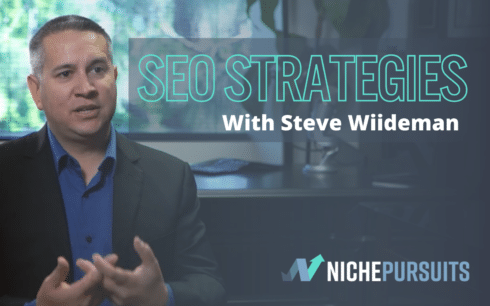By Spencer Haws
Today, I’m excited to share with you an interview I did with Steve Wiideman from Wiideman.com.
Steve has been in the SEO industry since 1999…a dinosaur in internet years! His first job out of college was doing SEO and search engine marketing.
So, Steve brings all of his SEO knowledge and experience to the podcast today.
In particular, we discuss how his SEO consulting group is working with clients doing local SEO, eCommerce SEO, and much more.
During the interview we discuss specifically how the Wiideman group helped Bob’s Watches:
- eCommerce SEO
- Bobs Watches has grown to over $40 million a year in revenue
- and much more
We also discussed his view on affiliate sites and how it relates SEO.
- Are affiliate sites really providing value or are they just doorway pages?
- What sort of link building and keyword research should be done?
- Ranking affiliate sites in Google
Steve is also a professor at Fullerton college and UCSD where he teaches SEO and online marketing.
He’s put together lots of video materials that he is giving away for free.
If you want to get free access to Steve Wiideman’s SEO videos you can go to AcademyOfSearch.com. Use coupon code SEOSteve to get free access.
If you’d like to follow along with Steve, be sure to head over to:
Watch Entire Interview with Steve Wiideman
Read Transcript
Hey Steve, welcome to the niche pursuits podcast.
Steve Wiideman: What’s up, Spencer, how are you doing? I’m doing really good.
Spencer Haws: It is great to connect and connect with an SEO veteran. You’ve been in the industry
Steve Wiideman: for a long time.
Spencer Haws: I do what I can and to know, but some of our listeners, maybe aren’t aware who you are. Right. So why don’t you give us just a quick background, who you are, what you’ve been involved with professionally.
Steve Wiideman: Of course. Yeah. So I started in digital, around the late nineties. I was freelancing doing some web design work for friends and family members. And. Really discovered a passion for it. One of my jobs, my I, my day job at IBM global services was to migrate data from what was going to printers and mail rooms to be online.
And I had this epiphany. I’m like, you know what? I’ll bet every business is going to have a website at some point, you know, and we’re talking late nineties, there were some sites didn’t even exist yet. Google didn’t even exist yet. And so, you know, I had that epiphany, I went back to school. I got a degree in e-business management.
You got to learn everything from database networking, graphic design, and pulling it all together through project management. And my first job out the Gates, my first professional job out the gate was as a search engine optimizer for a local. it’s more at the time it was more of a national, but I had a, brick and mortar location for monitors and that sort of thing.
And what year was your first job? Oh, geez. That was professionally. It was probably 2004, 2005. Okay. So before that I was just freelancing and going to school and, yeah, so 2000. Late 2005, I get a phone call saying, Hey, this this little company ran by a mouse, wants to hire you to manage paid advertising with this Google ad words and, and MSN ad center thing.
You know, could you, could you see if that’s something that’s a good fit for you? And I’m like work for Disney? That’d be amazing. So, I ended up actually being the STM account manager for disneyland.com, marketing and commerce marketing, you know, new Nemo ride grad night, commerce tickets, packages, reservations, and a new brand that they created called to adventures by Disney.
And that was an all flash website that couldn’t even be crawled or, you know, with no pages to index, there’s just a Swift file. So, you know, my, my role there, was mainly paid and I convinced my manager to give me a shot at this SEO thing. he, wasn’t very impressed that I ranked number one for.
Orange County SEO expert. And he said, tell you what show me that you can rank for SEO expert and we’ll talk. And so three months later after creating my SEO expert page and doing some promotion for it, adding video, getting some links to it. I’m on the first page. I’m like, like, Hey Terry, check it out.
I’m on the first page of Google for SEO expert. Let me do some SEO on these websites. And, and it comes back and goes, well, you’re not number one, few months later, I got the number one spot. I held it for 12 years, until I realized that my peer group and you know, that the community thought that it was bragging.
And I got blacklisted from a lot of speaking opportunities. the moment I dropped that some three years ago now. now I, I get the most amazing adventures with some of these peers that, that, before I thought I was just this guy that bragged about being number one for SEO expert. And now I get to go camping with these amazing friends and it was so worth it.
So that’s interesting.
Spencer Haws: So you think people didn’t like you because you ranked number one for SEO
Steve Wiideman: expert. And in fact, I, I saw lots of hate and blog posts and things back in the day that. It’s like, you don’t even know me. I, a few times I actually found the contact information of the people who wrote things about me and I’m like, Hey, let’s, let’s talk for a few minutes.
So you get to know who I am, you know? And then afterwards they post this guy actually had the audacity to call me. And, but it turns out he is actually a pretty cool guy, you know?
Spencer Haws: So I think that would be a good thing if you’re ranking for SEO expert.
Steve Wiideman: Well, I would just
Spencer Haws: ignore the haters.
They
Steve Wiideman: didn’t know what they were talking about anyways.
Yeah. Well, those, those haters now are my best friends and they’re so supportive of me. And when I get stuck on a really difficult technical or, or contextual SEO issue there they’re right there for me. So. we have some pretty exciting, amazing, you know, brands we get to work with now, a few restaurant chains, and I didn’t have that peer group around me, folks that were.
Just as experienced or veteran is as you call an earlier, you know, I don’t know that I’d be as successful. So I think it was worth it to, to move on from that what we’re going to hold list of new keywords. We’re going to try to tackle, but, I don’t think SEO expert is going to be one of them. Okay.
Spencer Haws: Well, so how did you actually end up making your first dollar online?
So you’re ranking for SEO expert. Was that kind of the first way you were getting clients or. Just curious. Yeah. How did you make your first
Steve Wiideman: dollar online? I think I started some of our own websites around 99 in 1999. I started to create some web directories. I had some web directories for, DJs and limousine drivers.
And at first it was just to help my, my friends and, and, you know, freelance clients that had those businesses. And then it evolved to something where I had people subscribing to my online directories. They pay an annual fee or monthly fee and. that was probably where I made the first dog was really just kind of creating my own line online directories.
All right.
Spencer Haws: that’s very cool. so what are all the businesses that you’re involved with now to kind of catch people up? You know, you’ve kind of given some of the history now, but, but what are you involved with now? is it just the one business? Wait a minute.com or. Is there
a
Steve Wiideman: portfolio there? I think, I think all of us, as we get started, you know, we, we get to a place after a couple of years, we own 500 domain names and we want to do something with all of them.
And we’ve got all these great ideas of what we want to do. that list has gone down, you know, it’s probably less than 70 domains that I own now, of which I probably use 10, some of which, are projects that I worked on with, students at some of the colleges I was doing guest speaking for and some mentoring for.
but the only two sort of companies or anything that I’m doing at the moment, one is just running our small group here at Wayman consulting. You know, we’ve got nine employees now and. we support everything from, you know, your local HVAC company to, you know, one of the largest restaurant, casual dining chains in the country.
and the other, the other sort of role I’m taking right now is an adjunct professor at Cal state Fullerton, UC San Diego. I’m not teaching six classes at Portland community college. So when everyone else gets off the clock and they go home and eat dinner and. You know, and watch the very entertaining news right now.
no I’m being sarcastic. I’m not, I’m, I’m putting courses together and helping students and helping the next generation of SEO so that, you know, in five, 10 years from now, You know, the, the, hopefully there’ll be more transparency, more ethics and more strategy and less, tactic, less, black hat and, you know, things that, that manipulate search results.
Instead, we’re building good foundations on how we, you know, how we handle digital marketing. So collectively I think I have. just over about 160 students. So, you know, it’s, it’s, because it’s an online course for digital certificate programs. Some of them are only one unit long. it’s not that challenging, but there are days where I’m like, I’m not going to get home tonight.
It doesn’t do things I’m doing, I’m running that demand at the moment. And, and with, wait a minute, we’ve got, you know, our, our training programs and our digital programs. And then I have the teaching side and the teaching side actually helps build a weight of insight. As we reinvent our website over the next month or two, it’s gonna be very educational and it’s going to leverage a lot of the content that I’ve created for the students.
Spencer Haws: Yeah. You know, I think it’s very cool that you’re teaching in college and the fact that there actually is a degree or courses for SEO and search engine marketing, that didn’t didn’t exist when I was going to college. I was actually surprised to hear that there was an E business, Degree when you graduated.
I didn’t know that existed back in there, but
Steve Wiideman: I got that postcard. I’m like really? Wow. I’m not going to say no to that. And then I saw a full sale, had a, an actual master’s degree program, like, Hmm. Should I go back to school and get a master’s degree? And, an e-business and I just never did. So did you graduate in, like, what
Spencer Haws: was it?
2003,
Steve Wiideman: 2004, 2004? Yeah. Okay. All right. So,
Spencer Haws: I hate to admit it, but I might be older than you. I graduated in 2002 and they didn’t have any online business courses that I was aware of. At least
Steve Wiideman: this was through Westwood college of technology and that’s awesome. It was a tech school, but. I also had a bit of a break between high school and college.
I had, you know, three years where I served in the us army in Fort hood. and then, you know, came back and did the work grind for a few years before I went back to school. So. Gotcha.
Spencer Haws: Very cool. So we did a brief call, before hitting record here and we kind of talked a little bit about what I’m involved with.
I mentioned that a lot of my listeners are building affiliate sites. I built a lot of affiliate sites and sort of in that discussion, you mentioned. Sorta that you don’t do your, your group doesn’t do a lot of consulting. I essentially asked you have any clients that are doing sort of affiliate marketing, you said no, not, not really.
and you sort of mentioned that, oftentimes, you know, affiliate sites are building a lot of doorway pages and, it’s just Google. Doesn’t really like that very much. It’s I’m
Steve Wiideman: paraphrasing. Yeah. A lot of, a lot of our effort is around lower funnel content. How do we drive customers? To our clients, you know, that the brick and mortars and the small stores and restaurants and some online, you know, e-commerce websites that we support where there’s an actual sale or a product.
So we can actually calculate ROI. One of the. One of the things that we really enjoy is geeking out on analytics and being able to say, Hey, you invested X, thousands of dollars in SEO this month and generated X dollars of revenue. It’s really to do that. Or you’re really easy to do that when you have an e-commerce website or a hybrid, if you’re a brick and mortar and you can place an online order, especially now during the pandemic, but can’t you do that with an affiliate site to some degree?
Yeah. I mean, you could do it where you’re, you’re calculating and importing data back. If you’re doing some. online ads to promote your, your page from an organic perspective, I suppose. Depending on how you’re doing it. If you’re doing it through a third-party network tying in which, which keywords generating traffic and that sort of thing can be a little more tricky with affiliate when there’s not a sale on the site itself, unless you’re drop shipping.
Of course job, ship’s different. Cause they’re still ordering on your website. I see.
Spencer Haws: When you, when do you want to get that granular data, right? You want to see that you ranked number one for this
Steve Wiideman: particular keyword. You want to see
Spencer Haws: how much this particular product sold from that page. cause, cause certainly we’re doing a lot as affiliate site owners, we’re doing a ton of analytics, you know, cause, that is the primary driver of traffic for affiliate sites is SEO.
Steve Wiideman: Right? Right. So if you were to perform a query right now for a product, with an intent to purchase, most of the results are going to be your, your Amazons and your, you know, your online stores. if you were to do a longer sweat, so query how, where compare versus ideas, strategies, tips, lists, right?
Those are the, the, the obvious opportunity for affiliate sites to create really rich long form content. Right. You’ll make recommendations within that content to, you know, to drive affiliate. We do have two affiliate clients that, that are in the medical industry and they’re selling like essential oils and those sorts of things.
And, and they’re doing really well because they create amazing content. They’ve got these great videos and like, hi, I’m Dr. So-and-so. And this is my wife, Dr. So-and-so and say, we’re going to be talking about backs, the unboxing, the YouTube videos that you know, that people are looking to decide whether they want to buy a product that.
You know, the, the product review keywords that you’re going after. I think there’s a huge opportunity there for affiliate marketing. but our, our forte has always been focused around, you know, direct sales and, you know, we really don’t have a lot of affiliate clients, but that’s not to say I don’t believe in it.
I think, I think affiliate’s amazing. And I think any, any entrepreneur, who’s not doing something to, to drive affiliate revenue. I mean our whole, our whole new website that we’re launching has a section for partners and folks that we recommend where the goal is to of course have affiliate relationship there.
So you’d be, you’d be silly not to diversify your, your online income streams by not doing a little bit of affiliate marketing. Right, right.
Spencer Haws: Yeah. No, and that’s, that’s good to hear just. To clarify for listeners, because most of them, that’s what they’re doing. You know, sort of those opportunities that you laid out said, Hey, there’s great opportunities for the comparison, the reviews, the lists, the all that, that, that’s exactly what I teach, and have been teaching for 10 years, right?
Is, is building these sort of niche affiliate sites. You write really in-depth content. You rank number one for Google for best XYZ product or. X versus Y product or whatever. and a lot of people built, you know, that’s their livelihood, you know, people do this full-time and they’re making really good money doing
Steve Wiideman: it at the equipment in my room was supposed to because of recommendations that I found likely.
Yeah. Ended up on BNH or somewhere else.
Spencer Haws: So just to clarify, you think Google is happy and, and they’re okay. Ranking this type of content affiliates that are building this in depth type of content that we just mentioned. Shouldn’t have to worry.
Steve Wiideman: No, not at all. I think, I think where they would have to worry is if, if they were trying to compete against a very behavioral targeted query, like by purchase order right out the gate, if you’re doing, you know, buy.
IPad case, you know, and, and I, I definitely encourage anyone who’s listening and watching to that, to do some of these queries where they’re using words like buy purchase order, reserve book, those, those types of call to actions, you know, really are conducive to somebody who’s in the, I need to buy now.
They’re not really interested right away to read an article. Their intent is I know what I want. I’m going to buy it. But if they’re in sort of mid funnel or upper funnel, it’s great. The greatest catalyst I can imagine. It’s more, you know, driving income through affiliate. back my, one of my first eBooks that I wrote in the two thousands was called SEO in a day.
And I went after, is it Monety or the little how’d you call it? It’s a saw you drink, right? Oh, I saw that they weren’t doing any, any sort of digital marketing for themselves and I’m like, all right, I’m going to pick, I want to pick one of these MLMs and just create a, a affiliate site and show that you can do optimization and get.
traffic and revenue in a day or less. And so we went through with this whole WordPress walk through our board, a little video on how to do it and create a content was up to like, you know, 10 o’clock at night creating content. The first thing that I optimized for was the thing that I had the most trouble with.
I couldn’t sign up. To become an affiliate without talking to an affiliate. I’m a tech introverted, you know, guy. I don’t at the time, I didn’t want to talk to anybody. So I did this search for Mondavi distributor ID, and I just wanted to set enters through your ID to sign up. I’m like, crap, I don’t have one.
They don’t want to talk to anybody. Five by pages into Google. I find a distributor ID and someone’s thread on some other website. And so I grabbed that and the very first page I create is Mondavi distributor. I need five, six, whatever, you know. Right, right. In the title of the page. And, you know, with, within a couple of weeks, I started getting calls from mom and be like, what are you doing?
You’re getting more downlines and more orders than like any of our affiliates who you working with, this, this person isn’t even responding to our emails. And I’m like, I don’t even know who the distributor ID was. I grabbed, I, I just, you know, I knew what I wanted. I was trying to find it and I optimized for it.
And so, yeah, four months later I’m getting checks from people who are buying this product and. so it was called STO in a day and it’s totally outdated now because it was pre Google penalties, like, you know, their penguin link penalty and they’re Panda content penalties. So a lot of the suggestions in there and the methods that I used to get links to the site quickly, you know, were obsolete.
But, but yeah, I love and passionate about it. Affiliate is I’m sure. All of us are awesome. Not
Spencer Haws: very cool. So, now you’re focusing more on, at least through Wiedemann group consulting. You’re more focused on local companies. e-commerce companies, those, those that, you know, they’re, they’re making purchases either on their side of they’re trying to drive foot traffic into their business potentially.
Steve Wiideman: Right, right. And part of it’s because you know, it, it gives us more of a challenge. You know, when, when we get a large corporate client who comes in and says, we’re on this really wonky CMS system, and we’re getting beat by all these competitors, what do we do? It gives us the opportunity to really challenge ourselves.
you know, the best could that competition and really big industries and, and, and explore and pioneer new areas of search. So, you know, for one of our restaurant chains, for example, we did a study recently of some 300 local pages. You know, if you have a brick and mortar company and you’ve got multiple locations, you’re going to have multiple pages or those locations.
And so we got to study all of those different pages and their attributes. What’s the difference between one that’s ranking higher and one that’s not, you know, and, and in doing that, you know, we’re, we’re creating and we’re building data and best practices and sort of the anatomy of a local landing page.
And, and that’s exciting because now, now you’re a pioneer now you’re. You’re someone who’s, who’s looked on as the guys who, who love to research and discover things and people will pay for the information. That’s the best part is we, as we do, you know, push a lot more of our educational stuff and the road, you know, the, the, the sales part of that and how we really generate revenue is when they purchase, you know, some of the research that we built.
Spencer Haws: So I wanted to ask a little bit about that. Just kind of how, your consulting group is set up. I understand that you’re not an agent agency, but you are a consulting group. So can you clarify that? And, and why is
Steve Wiideman: that? Sure. You know, I, I didn’t have a good experience in agency when I left the corporate world, 2008 or so I did two years in the agency and I was miserable.
I didn’t like it. How, how agencies treated clients in general. I didn’t like that. Yeah, the way that they they’ve really tried to have their secret sauce of what they do. And instead of being transparent, you know, when I, when I went off on my own and, you know, decided to be a freelance consultants, you know, late 2009, it was built around transparency.
Hey client, here’s all the things we’re going to do together. I’m gonna load it up into our project management system and we’re going to work together to get it done. And they’re like, wait, you’re giving me everything you do. Are you afraid? I’m just going to do it all myself. I mean, you’re looking at all this, so you really, you really want to do it all yourself.
Like no. So, and those clients that are DIY, they’re going to figure it out one way or the other. Anyway, those people who know and trust your expertise would feel better knowing that you’re their wing man. So we’re, we’re, we’re using a model that, that allows us to, to really help. Businesses to bring in their own SEO team, their own content writer, their own technical, you know, resources managing the tech side of SEO and their, their own outreach and link building digital PR teams.
And now all the things that they’re doing have the brand voice on them. And they’re, and they’re saving so much money. Once these resources get trained up and, and are able to do all the same things, agencies do. They get to save so much money in what would have gone to overhead and leadership and, you know, and, and, other costs.




























